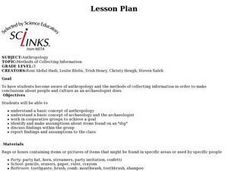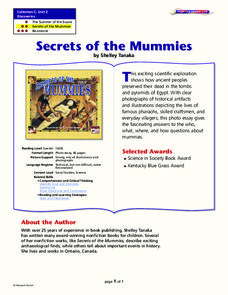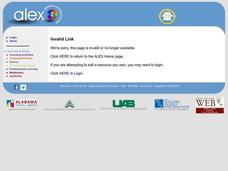Curated OER
Presidents
Students identify the qualities needed to become President of the United States. Using the internet, they discover the differences in character of past presidents and draw conclusions about their time in office. They relate a piece of...
Curated OER
Methods of Collecting Information
Third graders examine a bag or box of soil containing items that they dig for. Their task is to become detectives to make conclusions about the area from which the items came as real archaeologists do.
Curated OER
Sediment Deposition Lab
Learners set up a stream table, observe erosion, and record data on where various sizes of sediments settle. They draw conclusions as to what kind of sedimentary rock form in what locations.
Curated OER
Yeast Cells and their Environment
Students study the scientific method and explore how to design an experiment. In this investigative lesson students explore and hypothesis an experiment then carry it out to find the results.
Curated OER
Macbeth
Students examine patterns of imagery in Macbeth by using online resources. Students compare the patterns they see to those they've found in other Shakespeare plays. Then students draw conclusions about why Shakespeare might have used the...
Curated OER
A Midsummer Night's Dream
Pupils examine patterns of imagery in A Midsummer Night's Dream by using online resources. Students compare the patterns they see to those they've found in other Shakespeare plays. Then pupils draw conclusions about why Shakespeare might...
Curated OER
Othello
Students examine patterns of imagery in Othello by using online resources. Students compare the patterns they see to those they've found in other Shakespeare plays. Then students draw conclusions about why Shakespeare might have used the...
Curated OER
Merchant of Venice
Students examine patterns of imagery in Merchant of Venice by using online resources. Students compare the patterns they see to those they've found in other Shakespeare plays. Then students draw conclusions about why Shakespeare might...
Curated OER
Understanding Primary Sources
Pupils draw conclusions from primary sources and share information and interpretations with a small group. They are introduced to the Jigsaw technique. Students discuss why a grocery receipt would be a primary source. They brainstorm...
Curated OER
Healthy Snacks. Healthy Packaging
Fourth graders research how to select the most cost-effective snacks. In this consumer practices lesson plan, 4th graders compare packaging labels and come to conclusions on how cost effective the product is. Students discuss their...
Curated OER
Water Quality
Students examine water quality and how to improve it, how to measure it and how it relates to human activities. In this water quality lesson students sample water from different sources, and test the samples.
Curated OER
History: I'm Watching You 24/7
Students examine the growth of authoritarian societies. Focusing on North Korea, they watch video clips looking for examples of totalitarianism and identify the problems there. They write letters to the editors of local newspapers...
Curated OER
Drawing Conclusions
Middle schoolers play a probability game, then design and complete a probability problem concerning changing odds.
Curated OER
How to Keep a Scientific Journal
Young scholars record observations of a living organism over a period of time. They observe meal worms and record their observations in a scientific journal.
Curated OER
Forces in Action
Students ask questions that can be investigated scientifically. They determine how to plan a fair test by changing one factor while keeping other factors the same, to use measurements to draw conclusions and use scientific knowledge to...
Curated OER
What Can We Learn From the Past?
What would future archeologists learn from your scholars' personal belongings? Have them bring in a box of "primary sources" from their home. Discuss the difference between observations and inference, using some of your own items to...
Curated OER
Secrets of the Mummies
How did the ancient people of Egypt preserve their dead so well that their bodies are still recognizable today? Learn the painstakingly complex process they used for preservation. Young scholars read and summarize a narrative detailing...
Curated OER
Investigating Factors That Affect Cell Membrane Permeability
Cell membranes and the factors that affect its integrity are studied, with Beet tissue used as the model. A poster to display findings of the permeability of the membranes would clarify understanding and also allow a layer of language...
Curated OER
The Effect of Dissolved Salt on the Boiling Point of Water
Explore the properties of solutions with a lab activity. Chemistry fans determine the boiling point of water, add salt to create a solution, and then repeat the process four more times. They design their own data table and then graph the...
Curated OER
Making Money and Spreading the Flu!
Paper folding, flu spreading in a school, bacteria growth, and continuously compounded interest all provide excellent models to study exponential functions. This is a comprehensive resource that looks at many different aspects of these...
Curated OER
Reading A Historical Photograph
Students examine a historical photograph to gather information and draw conclusions.
Curated OER
Investigation 3 - Examining Your Fossil
Fourth graders examine the fossils they made previously. They examine the details of the fossil with a hand lens and come up with conclusions about the fossils. They record what they see and draw conclusions about the environment of the...
Curated OER
Hurricanes
Students study hurricanes and their patterns. In this hurricane lesson plan, students watch a video clip tracing Hurricane's Ivan's path in Alabama. Students discuss hurricanes and watch a 3-D video of Hurricane Ivan. Students visit a...
Curated OER
Fibers Lesson Plan
Students explain how to use a light microscope, describe how to care for a microscope, and solve a forensic science problem, using a microscope to analyze data and draw conclusions.

























